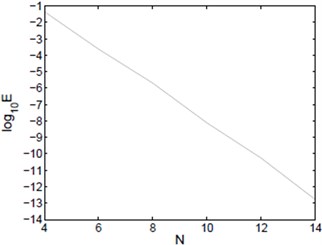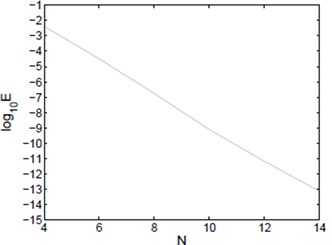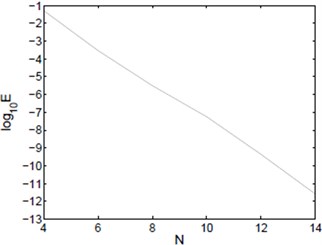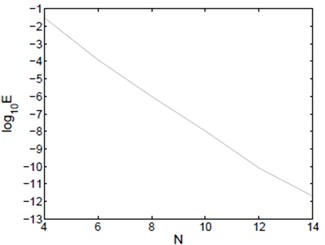Abstract
The Jacobi pseudo-spectral Galerkin method for the Volterra integro-differential equations of the second kind with a weakly singular kernel is proposed in this paper. We provide a rigorous error analysis for the proposed method, which indicates that the numerical errors (in the -norm and the -norm) will decay exponentially provided that the source function is sufficiently smooth. Numerical examples are given to illustrate the theoretical results.
1. Introduction
In practical applications one frequently encounters the Volterra integro-differential equations of the second kind with a weakly singular kernel of the form:
With the given initial condition . Where the unknown function is defined in . , are two given source functions and is a given kernel.
Equations of this type arise as model equations for describing turbulent diffusion problems. The numerical treatment of the Volterra integro-differential Eq. (1) is not simple, mainly due to the fact that the solutions of Eq. (1) usually have a weak singularity at 0, as discussed in [1], the second derivative of the solution behaves like .
We point out that for Eq. (1) without the singular kernel (i.e., 0) spectral methods and the corresponding error analysis have been provided recently [2]; see also [3] and [4] for spectral methods to Volterra integral equations and pantograph-type delay differential equations. In both cases, the underlying solutions are smooth.
In this work, we will consider a special case, namely, the exact solutions of Eq. (1) are smooth (see also [5]). In this case, the collocation method and product integration method can be applied directly. But the main approach used there is the spectral-collocation method which is similar to a finite-difference approach. Consequently, the corresponding error analysis is more tedious as it does not fit in a unified framework. However, with a finite-element type approach, as will be performed in this work, it is natural to put the approximation scheme under the general Jacobi-Galerkin type framework. As demonstrated in the recent book of Shen etc. [16], there is a unified theory with Jacobi polynomials to approximate numerical solutions for differential and integral equations. It is also rather straightforward to derive the pseudo-spectral Jacobi-Galerkin method from the corresponding continuous version. The relevant convergence theories under the unified framework, as will be seen from Section 4, are cleaner and more reasonable than those obtained in [7].
The purpose of this work is to provide numerical methods for the second kind Volterra integro differential equations based on pseudo-spectral Galerkin methods. Spectral methods are a class of techniques used in applied mathematics and scientific computing to numerically solve certain partial differential equations (PDEs) (see e.g. [8-10] and the references therein), often involving the use of the Fast Fourier Transform. Where applicable, spectral methods have excellent error properties, with the so called ”exponential convergence” being the fastest possible.
The paper is organized as follows. In Section 2, we introduce the Jacobi pseudo-spectral Galerkin approaches for the Volterra integro-differential Eq. (3). Some preliminaries and useful lemmas are provided in Section 3. In Section 4, the convergence analysis is given. We prove the error estimates in the -norm and -norm. The numerical experiments are carried out in Section 5, which will be used to verify the theoretical results obtained in Section 4. The final section contains conclusions.
2. Jacobi pseudo-spectral Galerkin method
In this section, we formulate the Jacobi pseudo-spectral Galerkin schemes for problem Eq. (1) For this purpose, let be a weight function in the usual sense, for , . , denote the Jacobi polynomials. The set of Jacobi polynomials forms a complete -orthogonal system. Before using pseudo-spectral methods, we need to restate problem Eq. (1). The usual way (see [1]) to deal with the original problem is: writing , Eq. (1) is equivalent to a linear Volterra integral equations of the second kind with respect to , :
For the sake of applying the theory of orthogonal polynomials conveniently, by the linear transformation:
Letting:
The weak form of Eq. (3) is to find , such that:
where denotes the usual inner product in the -space.
Now, let be any positive integer and be the set of all algebraic polynomials of degree at most . Obviously, the Jacobi polynomials , ,..., are the basis functions of .
Next, we denote the collocation points by , which is the set of (1) Jacobi Gauss point. We also define the Jacobi interpolating polynomial , satisfying:
It can be written as an expression of the form:
where is the Lagrange interpolation basis function associated with the Jacobi collocation points .
Now we describe the Jacobi pseudo-spectral Galerkin method. For this purpose, set:
We define that:
Using ()-point Gauss-Jacobi quadrature formula with weight to approximate Eqs. (6)-(8) yields:
where are the (1)-degree Jacobi-Gauss points associated with , and are the corresponding Jacobi weights. On the other hand, instead of the continuous inner product, the discrete inner product will be implemented by the following equality:
as a result , if .
By the definition of , we have:
The Jacobi pseudo-spectral Galerkin method is to find:
such that:
where and are determined by:
Denoting , Eq. (14) yields a equation of the matrix form:
where:
3. Some useful lemmas
We first introduce some Hilbert spaces. For simplicity, denote , etc. For a nonnegative integer , define:
with the semi-norm and the norm as:
respectively. It is convenient sometime to introduce the semi-norms:
For bounding some approximation error of Jacobi polynomials, we need the following nonuniformly-weighted Sobolev spaces:
equipped with the inner product and the norm as:
Next, we define the orthogonal projection as:
where possesses the following approximation properties ((5.4.11), (5.4.12) and (5.4.24) on p. 283-287 in Ref. ([11]):
and:
We have the following optimal error estimate for the interpolation polynomials based on the Jacobi Gauss points (c.f. [7]).
Lemma 3.1 For any function satisfying , we have:
for the Jacobi Gauss points and Jacobi Gauss-Radau points.
Lemma 3.2 If , for some and , then for the Jacobi Gauss and Jacobi Gauss-Radau integration we have (cf. [7]):
We have the following result on the Lebesgue constant for the Lagrange interpolation poly-nomials associated with the zeros of the Jacobi polynomials; (cf. [7]).
Lemma 3.3 Let be the -th Lagrange interpolation polynomials associated with the Gauss, or Gauss-Radau, or Gauss-Lobatto points of the Jacobi polynomials. Then:
We now introduce some notation. For and , will denote the space of functions whose -th derivatives are Holder continuous with exponent , endowed with the usual norm . When 0, denotes the space of functions with continuous derivatives on [0, ], also denoted by , and with norm .
We will make use of a result of Ragozin ([12-13]), which states that, for each nonnegative Integer and there exists a constant 0 such that for any function there exists a polynomial function such that:
where is the norm of the space and when the function Actually, is a linear operator from to .
We will need the fact that , which be defined by Eq. (11), is compact as an operator from to for any [14].
Lemma 3.4 Let , then, for any function , there exists a positive constant such that:
under the assumption that for any , and . This implies that:
Clearly, and also satisfy Eq. (24). In our analysis, we shall apply the generalization of Gronwalls lemma. We call such a function locally integrable on the interval [0, ] if for each , its Lebesgue integral is finite. The following result can be found in [15].
Lemma 3.5 Suppose that:
where , and are locally integrable on the interval [0, ]. Here, all the functions are assumed to be nonnegative. Then:
Lemma 3.6 Assume that is a nonnegative, locally integrable function defined on [0, ] and satisfying:
where is a positive constant and is a nonnegative and continuous function defined on [0, ]. Then, there exists a constant such that:
Proof. We note that when , the integral is finite. From Lemma 3.5, we obtain the desired result directly.
Lemma 3.7 Assume that is a nonnegative, locally integrable function defined on [−1, 1] and satisfying:
where is a positive constant and is a nonnegative and continuous function defined on [−1, 1]. Then, there exists a constant such that:
Proof. Let , , we obtain that:
Using Lemma 3.6 leads to:
By the linear transformation , , desired result follows. Obviously, when 0, the lemma 3.7 also holds.
To prove the error estimate in the weighted -norm, we need the generalized Hardys inequality with weights (see, e.g., [16, 17]).
Lemma 3.8 For all measurable function 0, the following generalized Hardys inequality:
holds if and only if:
for the case . Here, is an operator of the form:
with a given kernel, , weight functions, and .
We will need the following estimate for the Lagrange interpolation associated with the Jacobi Gaussian collocation points.
Lemma 3.9 For every bounded function , there exists a constant independent of such that:
where is the Lagrange interpolation basis function associated with the Jacobi collocation points .
Proof. It is obvious that:
By the Lemma 3.3, we obtain the desired result.
Lemma 3.10 For every bounded function , there exists a constant independent of such that:
where is the Lagrange interpolation basis function associated with the Jacobi collocation points .
Proof. It is obvious that:
where . As a consequence:
with
4. Convergence for Jacobi pseudo-spectral-Galerkin method
As is the interpolation operator which is based on the (1)-degree Jacobi-Gauss points with weight , in terms of Eqs. (13) and (14), the pseudo-spectral Galerkin solution , satisfies:
where:
with:
in which represents the continuous inner product with respect to , and is the corresponding discrete inner product defined by the Gauss-Jacobi quadrature formula. Similar to Eq. (25), we have that:
with:
and:
with:
The combination of Eqs. (24)-(27) yields:
which gives rise to:
By the discussion above, Eqs. (14), (24) and (28) are equivalent.
We first consider an auxiliary problem. We want to find , such that:
where , and are the integral operators defined in Section 2, and is still the discrete inner product based on the (1)-degree Jacobi-Gauss points. In terms of the definition of , Eq. (29) can be written as:
which is equivalent to:
When , Eq. (31) can be written as:
In terms of the fact that:
Suppose that:
It is clear that from Eq. (6)-(8):
which yields:
where Using Lemma 3.7 leads to:
namely:
We now estimate and By virtue of Eqs. (22), (23) and Lemma 3.9, we obtain that:
Similarly:
and:
These, together with Eq. (32), give:
which implies, taking , such that when is large enough, 0. Hence, the and are existent and unique as is finite-dimensional.
Lemma 4.1. Suppose that and:
then we have:
Proof. Subtracting Eq. (31) from Eq. (3) yields:
Set , . Direct computation shows that:
and:
The insertion of Eqs. (36), (37) into Eq. (35) yields:
which implies that:
where:
Using Lemma 3.7 gives:
Then, it follows from Eq. (39) that:
By using Eq. (18), Lemma 3.9, we obtain that:
and:
We now estimate it is clear that Consequently, using Eqs. (22), (23) and Lemma 3.9 it follows that:
where and . Eq. (43) also holds for and . Taking , such that , the estimate Eq. (33) follows from Eqs. (40)-(43), provider that is large enough.
Next we prove Eq. (34). Using the generalized Gronwall inequality (Lemma 3.8), we have from Eq. (38) that:
We obtain that from Eqs. (22), (23) and Lemma 3.10:
These result, together with the estimates Eqs. (33), (44) and (19), yields (34).
Now subtracting Eq. (28) from Eq. (31) leads to:
which can be simplified as, by setting , :
Let and be the error corresponding to the Jacobi pseudo-spectral Galerkin solution , of Eq. (14). Now we are prepared to get our global convergence result for problem Eq. (3).
Theorem 4.1. Suppose that:
and the solution of Eq. (3) is sufficiently smooth. For the Jacobi pseudo spectral Galerkin solution defined in Eq. (14), we have the following estimates:
1) norm of satisfies:
2) norm of satisfies:
Proof. We first prove the existence and uniqueness of the Jacobi pseudo-spectral Galerkin solution , . As the dimension of is finite and Eqs. (14) and (28) are equivalent, we only need to prove that the solution of Eq. (28) is when
For this purpose, we consider the equation:
Obviously Eq. (48) can be written as:
and:
namely:
With:
Using Eq. (49) gives:
Namely:
Using Lemma 3.7 yields:
On the other hand, according to Lemma 3.9:
By the expression of in Eq. (25), Lemma 3.2, we have:
which, together with Eq. (52), gives:
Similarly, Eq. (53) holds for and .
The combination of Eqs. (43) and (53) yields:
Based on Eq. (54) and Lemma 3.4 with when is large enough, . As a result, the existence and uniqueness of the Jacobi pseudo-spectral Galerkin solutions , are proved.
Now we turn to the error estimate. Actually Eq. (45) can be transformed into:
which yields:
with , , .
Similar to Eq. (52), it follows from Eq. (56) and Lemma 3.7 that:
Similar to the estimate of Eq. (43), we obtain:
It also holds for and . In terms of Eqs. (53), (57) and (58), when is large enough, we obtain:
By the triangular inequality:
as well as Eqs. (59), (60) and Lemma 4.1, we can obtain the estimated Eq. (46) provided is sufficiently large.
Next we prove Eq. (47). Using Lemma 3.7 and the generalized Hardy inequality (Lemma 3.8, 2), one obtains that from Eq. (56):
The combination of Eqs. (53), (58) and (59) yields:
By the triangular inequality again:
In terms of Eqs. (46), (62), (63) and Lemma 4.1, we obtain the desired result.
5. Numerical results
We give two numerical examples to confirm our analysis.
Example 1. Consider the Volterra integro-differential equation:
The exact solution is . Fig. 1 shows the errors of approximate solution in and Fig. 2 shows the errors weighted norms obtained by using the Pseudo-spectral methods described above. It is observed that the desired exponential rate of convergence is obtained.
Example 2. Consider the Volterra equation integro-differential equation:
The corresponding exact solution is given by . Fig. 3 and Fig. 4 plot the errors for 214 in and norms. Once again the desired spectral accuracy is obtained.
Fig. 1L∞ error of Example 1

Fig. 2Lω-μ,-μ2 error of Example 1

Fig. 3L∞ error of Example 2

Fig. 4Lω-μ,-μ2 error of Example 2

6. Concluding remarks
This work is concerned with the Jacobi pseudospectral-Galerkin methods for solving Volterratype integro-differential equation and the error analysis. To facilitate the use of the methods, we first restate the original integro-differential equation as two simple integral equations of the second kind, then the spectral accuracy associated with and error estimates are demonstrated theoretically. These results are confirmed by some numerical experiments.
We only investigated the case when the solution is smooth in the present work, with the availability of this methodology, it will be possible to extend the results of this paper to the weakly singular VIDEs with nonsmooth solutions which will be the subject of our future work.
References
-
Brunner H. Collocation Methods for Volterra Integral and Related Functional Equations. Cambridge University Press, Cambridge, 2004.
-
Chen Y., Tang T. Spectral methods for weakly singular Volterra integral equations with smooth solutions. Journal of Computational and Applied Mathematics, Vol. 233, 2009, p. 938-950.
-
Tao Xia, Xie Ziqing, Zhou Xiaojun Spectral Petrov-Galerkin methods for the second kind Volterra type integro-differential equations. Numerical Mathematics: Theory, Methods and Applications, Vol. 4, Issue 2, 2011, p. 216-236.
-
Ali I., Brunner H., Tang T. A spectral method for pantograph-type delay differential equations and its convergence analysis. Journal of Computational Mathematics, Vol. 27, Issues 2-3, 2009, p. 254-265.
-
Brunner H., Schotzau D. Hp-discontinuous Galerkin time-stepping for Volterra integro-differential equations. SIAM Journal on Numerical Analysis, Vol. 44, 2006, p. 224-245.
-
Shen J., Tang T., Wang L.-L. Spectral Methods: Algorithms, Analysis and Applications. Springer Series in Computational Mathematics. Springer, New York, 2011.
-
Wang W. Mechanical algorithm for solving the second kind of Volterra integral equation. Applied Mathematics and Computation, Vol. 173, 2006, p. 1149-1162.
-
Bock I., Lovisek J. On a reliable solution of a Volterra integral equation in a Hilbert space. Applications of Mathematics, Vol. 48, Issue 6, 2003, p. 469-486.
-
Brunner H. The numerical solutions of weakly singular Volterra integral equations by collocation on graded meshes. Mathematics of Computation, Vol. 45, 1985, p. 417-437.
-
Brunner H. Polynomial spline collocation methods for Volterra integro-differential equations with weakly singular kernels. IMA Journal on Numerical Analysis, Vol. 6, 1986, p. 221-239.
-
Canuto C., Hussaini M. Y., Quarteroni A., Zang T. A. Spectral Methods Fundamentals in Single Domains. Springer-Verlag, Berlin, 2006.
-
Ragozin D. L. Polynomial approximation on compact manifolds and homogeneous spaces. Transactions of the American Mathematical Society, Vol. 150, 1970, p. 41-53.
-
Ragozin D. L. Constructive polynomial approximation on spheres and projective spaces. Transactions of the American Mathematical Society, Vol. 162, 1971, p. 157-170.
-
Chen Y., Tang T. Convergence analysis of the Jacobi spectral-collocation methods for Volterra integral equations with a weakly singular kernel. Mathemacics of Computation, Vol. 79, 2010, p. 147-167.
-
Willett D. A linear generalization of Gronwall’s inequality. Proceedings of the American Mathematical Society, Vol. 16, Issue 4, 1965, p. 774-778.
-
Gogatishvili A., Lang J. The generalized Hardy operator with kernel and variable integral limits in Banach function spaces. Journal of Inequalities and Applications, Vol. 4, Issue 1, 1999, p. 1-16.
-
Kufner A., Persson L. E. Weighted Inequalities of Hardy Type. World Scientific, River Edge, NJ, 2003.
-
Atkinson K. E. A Survey of Numerical Methods for the Solution of Fredholm Integral Equations of the Second Kind. SIAM, Philadelphia, 1976.
-
Lubich Ch. Fractional linear multi-step methods for Abel-Volterra integral equations of the second kind. Mathematics of Computation, Vol. 45, 1985, p. 463-469.
-
Federson M., Bianconi R., Barbanti L. Linear Volterra integral equations as the limit of discrete systems. Cadernos de Matematica, Vol. 4, 2003, p. 331-352.
-
Shen J., Tang T. Spectral and High-Order Methods with Applications. Science Press, Beijing, 2006.
-
Tang T. A note on collocation methods for Volterra integro-differential equations with weakly singular kernels. IMA Journal of Numerical Analysis, Vol. 13, 1993, p. 93-99.
-
Tang T., Xu X., Chen J. On spectral methods for Volterra type integral equations and the convergence analysis. Journal of Computational Mathematics, Vol. 26, 2008, p. 825-837.
-
Jiang Y. J. On spectral methods for Volterra-type integro-differential equations. Journal of Computational and Applied Mathematics, Vol. 230, 2009, p. 333-340.
-
Wan Zhengsu, Chen Yanping, Huang Yunqing Legendre spectral Galerkin method for second-kind Volterra integral equations. Frontiers of Mathematics in China, Vol. 4, Issue 1, 2009, p. 181-193.
About this article
This work was financially supported by the National Natural Science Foundation of China (51279099), Shanghai Natural Science Foundation (12ZR1412500), Innovation Program of Shanghai Municipal Education Commission (13ZZ124).
